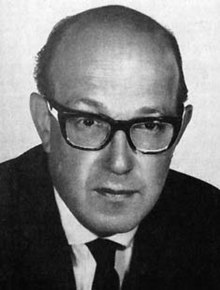Jay Livingston
Jay Livingston | |
|---|---|
 Livingston | |
| Born | Jacob Harold Levison March 28, 1915 McDonald, Pennsylvania, U.S. |
| Died | October 17, 2001 (aged 86) Los Angeles, California, U.S. |
| Alma mater | University of Pennsylvania |
| Occupation | Composer |
| Years active | 1937–2001 |
| Spouse(s) | Lynne Gordon (1947–1991; her death; 1 child) Shirley Mitchell (1992–2001; his death) |
Jay Livingston (born Jacob Harold Levison; March 28, 1915 – October 17, 2001) was an American composer best known as half of a song-writing duo with Ray Evans that specialized in songs composed for films. Livingston wrote music and Evans the lyrics.
Early life and career
Livingston was born in McDonald, Pennsylvania to Jewish parents.[1][2] He had an older sister, Vera, and a younger brother, Alan W. Livingston, who became an executive with Capitol Records, and later with NBC television.
Livingston studied piano with Harry Archer in Pittsburgh, Pennsylvania. He attended the University of Pennsylvania, where he organized a dance band and met Evans, a fellow student in the band. Though they began writing together in 1937, Livingston and Evans did not hit the top until 1946, when they set the music publishing business on fire with "To Each His Own," which reached number one on the Billboard charts for three different artists,[3] and occupied the top five positions on the "Most Played On the Air" chart for four different weeks (August 24, 1946, and again on September 7, September 14 and October 5, five versions appeared simultaneously in the Top Ten).[4][5][6][7] "Buttons and Bows" (1947) was their next multi-million seller, with four artists reaching the top ten in 1948, and won the Academy Award for Best Song. They finished off the decade with 1949's "Mona Lisa", which was a chart hit for seven popular and two country artists in 1950, sold a million for Nat King Cole, and won the pair another Best Song Oscar.[8][9] Their third Oscar came in 1956 for the song "Que Sera, Sera (Whatever Will Be, Will Be)," featured in the movie The Man Who Knew Too Much. They also wrote "Tammy" for the movie Tammy and the Bachelor in 1957.
Livingston and Evans wrote popular TV themes for shows including
Livingston appeared as himself with Evans in the New Year's Eve party scene of the 1950 film Sunset Boulevard, which featured his future sister-in-law, Nancy Olson.
Honors
Livingston is an inductee in the Songwriters Hall of Fame.[11] In 2004, the Pennsylvania Historical and Museum Commission installed a historical marker in McDonald, Pennsylvania, commemorating his achievements.[12]
Death
Livingston died in Los Angeles and was interred there in Westwood Memorial Park Cemetery, his tombstone reading, "Que Será, Será".[13]
His wife, actress Shirley Mitchell, died on November 11, 2013, at 94.
Work on Broadway
- Tony nomination for Best Musical
- Let It Ride (1961) – musical – co-composer and co-lyricist with Ray Evans
- Sugar Babies (1979) – revue – featured songwriter with Ray Evans for "The Sugar Baby Bounce"
References
- ^ Bloom, Nate (2006-12-19). "The Jews Who Wrote Christmas Songs". InterfaithFamily. Retrieved 2006-12-19.
- ^ Bloom, Nate (December 22, 2014). "All those Holiday/Christmas Songs: So Many Jewish Songwriters!". Jewish World Review.
- ^ "Ten tunes in forthcoming films". Long Beach Press Telegram Newspaper Archives. April 24, 1948. p. 22. Retrieved Jan 13, 2023.
- ^ "Records Most Played on the Air". Billboard. October 5, 1946. p. 24. Retrieved May 14, 2016.
- ^ "Records Most Played on the Air". Billboard. September 14, 1946. p. 26. Retrieved March 27, 2017.
- ^ "Records Most Played on the Air". Billboard. September 7, 1946. p. 28 and 116. Retrieved March 27, 2017.
- ^ "Records Most Played on the Air". Billboard. August 24, 1946. p. 27 and 112. Retrieved March 27, 2017.
- ISBN 0-89820-083-0.
- ^ "The Ray & Wyn Ritchie Evans Foundation | The official website of Ray Evans, American songwriter, Livingston and Evans, Music, Archives, Films". www.rayevans.org. Retrieved 2023-01-13.
- ^ "Livingston Obituary". All Things Considered. NPR. October 18, 2001.
- ^ "Songwriters Hall of Fame - Barry Gibb Exhibit Home". songwritershalloffame.org. Archived from the original on December 20, 2008. Retrieved March 23, 2018.
- ^ "Jay Livingston (1915-2001) - PHMC Historical Markers". Historical Marker Database. Pennsylvania Historical & Museum Commission. Archived from the original on December 7, 2013. Retrieved December 10, 2013.
- ^ Sam Staggs, Born to be Hurt: The Untold Story of Imitation of Life (2009), p. 216.
External links
- Jay Livingston obituary from The New York Times
- Jay Livingston biography Archived 2005-05-08 at the Wayback Machine
- Jay Livingston - Lifetime Sammy Film Music Award
- Jay Livingston at the Internet Broadway Database
- Video on YouTube(begins at 41:32) appearance with Chuck Schaden and members of the Gildersleeve cast: Willard Waterman, Mary Lee Robb and Shirley Mitchell. Songwriter Jay Livingston (Shirley's husband) entertains with a mini- concert featuring his many hit songs. Recorded at the Museum of Broadcast Communications, Chicago. (113 minutes).
- Jay Livingston Interview NAMM Oral History Library (1995)
- Livingston and Evans Official Site
